- Joined
- Aug 21, 2009
- Messages
- 402
- Reaction score
- 159
- Website
- www.africanindaba.co.za
- Media
- 70
- Articles
- 182
- Member of
- CIC, Rowland Ward, B&C, DSC, German Hunting Association, KZN Hunting Association, Wild Sheep Foundation
- Hunted
- Western US, Western Canada, Alaska, Colombia, Tajikistan, Russian Federation, China, Iran, Austria, Germany, Spain, Czech Republic, UK, Indonesia, South Africa, Zambia, Zimbabwe, Congo, Tanzania, Uganda, Botswana, Namibia
Central African Giant Eland - Cameroon versus C.A.R.
by Peter Flack
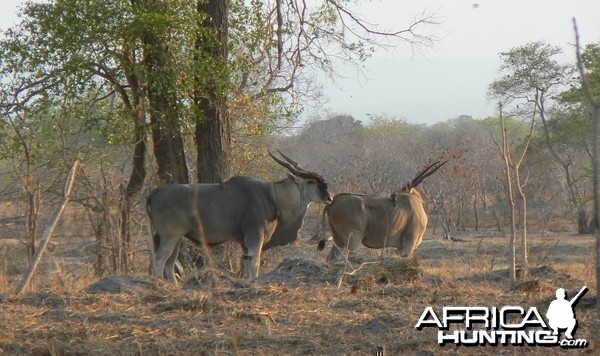
East African Giant Eland in C.A.R., also known as Lord Derby Eland. Picture by Christophe Morio
Editor’s Remarks: (Source IUCN Red List 2008) Giant Eland inhabit woodlands and forested Sudanian to Guinean savannas, never far from hilly/rocky landscapes nor from water (Planton and Michaux in press). Kingdon (1997) considered that it is quite strictly confined to lsoberlinia doka woodland, but recent studies indicate that its range includes areas of Terminalia-Combretum-Afzelia woodland where there is no Isoberlinia, e.g., in parts of Cameroon’s North Province such as Boumedje Hunting Concession (Bro-Jorgensen 1997). Giant Elands feed mostly on leaves, shoots, herbs and fruits (but occasionally on grasses), and will drink daily where water is available (Planton and Michaux in press).There are two recognized subspecies of Giant Eland, Tragelaphus derbianus.
The Western Giant Eland (T. d. derbianus) is listed as Critically Endangered C2a(ii). This subspecies still occurs in southeastern Senegal, the far north of Guinea, probably south-western Mali and possibly eastern Guinea-Bissau (East 1999; Darroze 2004; Planton and Michaux in press).
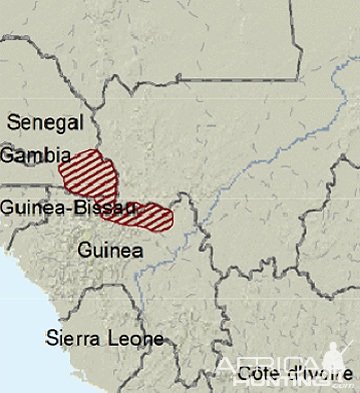
Distribution Map Western Giant Eland
The Eastern Giant Eland T. d. gigas (East 1999) which Peter Flack deals with in this article is Iisted as Least Concern. Eastern Giant Eland are one of the most sought after antelope trophies and sustainable safari hunting is having a positive effect on the conservation of populations in many areas. Eastern Giant Elands occur in the central African region, and were formerly distributed from north-eastern Nigeria to north-west Uganda. They now survive mainly in north-east Central African Republic. A separate population lives in northern Cameroon, with herds crossing the Chad border to the east; occasional vagrants may enter Nigerian territory. They may still occur in south-western Sudan, from which they may visit north-eastern DR Congo and north-west Uganda (East 1999; Planton and Michaux in press). East (1999) estimated that there are probably more than 15,000 Eastern Giant Eland remaining, with over 12,500 in the CAR. Numbers have increased in CAR, Cameroon and Chad since the 1990s. The numbers that survive in Sudan are unknown, but could be substantial. This suggests a total population of the Eastern Giant Eland in the order of at least 15,000~20,000. Its numbers are probably more or less stable over large areas of its range in Central African Republic and Cameroon where human population densities are very low. However, the Eastern Giant Eland’s overall, long-term population trend is probably gradually downwards (East 1999).
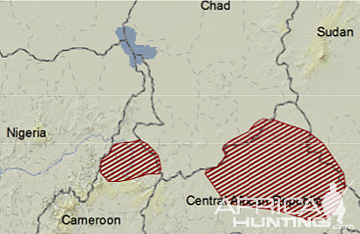
Distribution Map Eastern Giant Eland
For more years than I care to remember, I have repeatedly heard hunters say that giant eland were much bigger in C.A.R. than in Cameroon. In fact, I heard it so often and from so many people that I automatically assumed it was true and confess that I have also repeated this statement as if it were gospel. But is it?
50 years ago you could have hunted these magnificent animals in five countries – C.A.R., Cameroon, Sudan, Chad and the Congo. 40 years ago the Congo slipped off the giant eland radar screen and was joined by Sudan and Chad some 15 years later. Today, only Cameroon and C.A.R. still remain as viable Central African giant eland hunting destinations. Elsewhere, Lord Derby’s eland have all been eaten.
These events are clearly reflected in Rowland Ward’s Records of Big Game. Altogether, there are 357 Central African giant eland (as opposed to West African giant eland which can no longer be hunted) entries which exceed the minimum entry level of 44 7/8 inches. Of these, 200 are from C.A.R., 53 from Sudan, 50 from Chad, 32 from Cameroon, seven from the Congo and 15 from unknown countries.
The world record, measured around the spiral, was shot by Darryl Hastings in 2004 in Ndele Province, C.A.R. The longest horn measured a whopping 56 ¾ inches. The world record measured according to the previous silhouette measuring system was shot by Ms. Blancpain in 1954. The location was given as north eastern Obangui, Zaire and the longest horn measured 47 5/8 inches. More importantly, C.A.R. accounted for nine out of the top ten entries, 18 out of the top 20 and 26 out of the top 30. That is an impressive percentage and, judged by the record book alone, the evidence would seem to be conclusive. C.A.R. rules the roost. But does it still do so today?
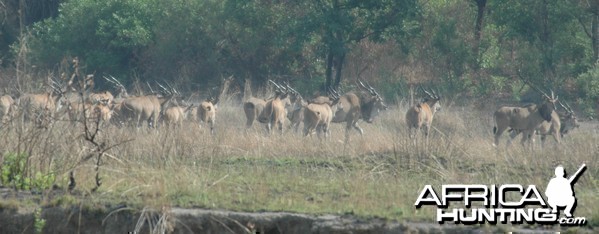
East African Giant Eland herd in C.A.R. Picture by Christophe Morio
Last year reports were published stating that Mr. Marc Watts had shot a huge giant eland in C.A.R. which would rank in the top three in the world. Of course, everyone knows that trophies measured in the field during the excitement and success of the moment are prone to shrink, not only from natural causes but also from fright when they reach the taxidermist and are confronted by an official measurer’s official tape measure and I look forward to seeing these measurements in print in a reputable record book. Even taking the wonders of modern photography into account, the tremendous animal shot by Mr. Watts looked hugely impressive to say the least and certainly provided anecdotal evidence that C.A.R. was continuing to produce the goods.
I also hunted in C.A.R. in March last year, admittedly not the best time for giant eland and, during the entire 21 day hunt, saw only three giant eland herds, only one of which held a shootable bull which probably would have measured 47 to 48 inches. I did not have a shot at him and, after 11 long days on the tracks, went home empty handed. My hunting partner only managed a mediocre 47 inch bull on the nineteenth day of our hunt. What was more instructive, however, was that although all ten previous hunters had shot giant eland, when I examined their hard won trophies in the skinning shed, only one measured in the region of 49 inches while all the rest were the same as my friend’s.
The quota for our concession was 12 bulls. As a game rancher of some 20 years standing, I know that to retain trophy quality I must confine my offtake of trophy males to between three and five per cent of my game numbers. In other words, to be sustainable, the quota would presuppose approximately 250 to 400 giant eland in the concession and, after a total of 42 hunting man days of dawn to dusk hunting, during which time we drove, walked and glassed the entire concession, we certainly saw no sign of such numbers. Admittedly, giant eland do wander and it is well known that, at different times of the year, much like caribou, eland numbers in a particular area can vary from fleas on a dog’s back to zero. Nevertheless, we were hunting in one of, if not the, most famous giant eland concession in the whole of C.A.R. (made famous by Giorgio Grasselli, the author of the book, African Sunsets, published by Rowland Ward, in 2007) with highly experienced and capable French professional hunters with extensive knowledge of the area. And it is not sour grapes speaking. Apart from the eland, I had a fantastic hunt with a professional hunter that I both liked and rated very highly. I took home an excellent bag consisting of a bongo, giant forest hog, red river hog, yellow-backed duiker and oribi. All were good, highly sought after trophies and the bongo was exceptional.
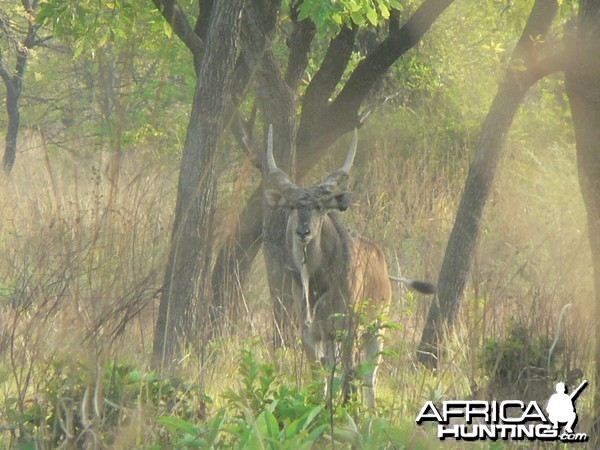
East African Giant Eland in C.A.R., also known as Lord Derby Eland, Picture by Christophe Morio
Contrast this experience with my hunt in the northern, Sahelian region of Cameroon in January of this year, not too far from the large, regional town of Garoua, with Mayo Oldiri. During my giant eland hunt I saw substantial herds of these animals each day and could have shot a good representative bull each day that I spent on the tracks. Admittedly these were only three in number but, on questioning the three PHs I met there, I was told that this was, and had been, par for the course for some years. Certainly no-one took longer than a week to find a good, representative bull.
Two bulls shot in 2009 measured over 50 inches – the giant eland holy grail - but, of the remaining 14 eland shot this season in Mayo Oldiri’s concessions, none joined this select group while the average for the year was just over 47 inches, well over the minimum entry level into Rowland Ward of 44 7/8 inches. I contacted two other highly reputable outfitters in the area – Faro West and Faro East (previously called Faro Koti Manga) but only Patrick Dahlen, owner of the latter company, replied. Over the last six years they have shot three plus 50 inch bulls. The smallest was 44 inches and, of the balance, over 90 per cent measured between 47 and 49 inches. OK you doubting Thomases, I know what you are thinking – how scared did these trophies become when they hit the taxidermist and the dreaded official tape measure. That, I’m afraid, I can’t answer.
But let’s assume for the moment that the pendulum has swung in Cameroon’s favour. What could have caused the change? The most obvious answer is poaching. Quite simply, in my opinion, it is out of control in C.A.R. and that hackneyed response that the Sudanese only poach elephant may have been correct once but no longer. What is true is that the Sudanese are the main poachers but today they are ably aided and abetted by the locals with whom they are often in cahoots. They supply the Sudanese with everything from intelligence to porters to food and I can speak from first hand experience. We found signs of poaching in almost every bako we crossed – a camp, blood spoor of wounded animals, fires, tracks, rifle shots and once a group of porters.
In the 1990s, when I first hunted in C.A.R., poaching was confined to the eastern border region of the country. A few years later, the safari outfitter I used, Ubangui Safaris, was forced out of this area by poachers and, today, poachers control the eastern half of the country.
During my hunt last year, my PH told me that, earlier in the season, he had found two horses in the veld. He took them back to camp thinking that he and his fellow guides could ride them. A few mornings later they were woken by the arrival of some 15 heavily armed Sudanese who not only reclaimed their horses but instructed the guides that they were poaching elephants in the area and, if they knew what was good for them, they would stay out of their way.
In the month after I left, the poachers ambushed a white Land Cruiser, similar to the one used by the small anti-poaching squad employed by the outfitters in the area. The driver, the late Daniel Breyton, a camp manager and a woman on the back of the vehicle were killed and others wounded. Clearly, the poachers were convinced that they could behave like this with impunity and rumours have long circulated that cabinet ministers in both C.A.R. and Sudan have funded these poaching teams.
In stark contrast, I was surprised while out hunting in Cameroon by a heavily armed, 12 man, anti-poaching squad from the neighbouring national park. In addition, the outfitters can call on a rapid reaction unit specially trained to deal with poachers and other rural criminals which has been remarkably effective in this part of Cameroon. And yes, the national park still worked (sort of) and had game, unlike the one in C.A.R. near our concession which had long since been poached into extinction. Please don’t get me wrong. Cameroon is no bed of blushing roses. Far from it. Although the country is often best known for the exploits of its soccer teams at the World Cup, Cameroon competes most effectively in another arena and has been awarded the trophy three times in the last 11 years by Transparency International for the most corrupt country in the world. Its hunting camps have also not escaped the violence experienced in C.A.R. Hunters have been robbed in their camps. A PH was arrested for murder after defending himself against an attack by an armed poacher he was trying to apprehend and his camp was subsequently burnt down. I was there when a senior wildlife official arriving in our camp and demanded money quite openly. He made it crystal clear that should we refuse he would not issue export permits for our trophies. But, when allis said and done, my impression is that the scale of poaching, although bad and becoming worse, is not anywhere near the scale of that in C.A.R.
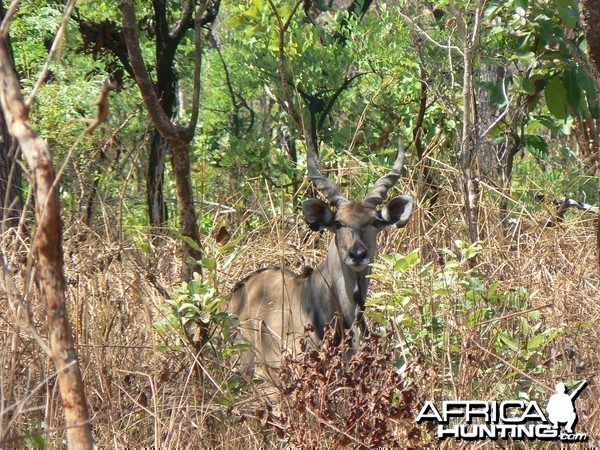
East African Giant Eland in C.A.R., also known as Lord Derby Eland. Picture by Christophe Morio
And that can be seen clearly in general game numbers. I have hunted three times in C.A.R. (twice in the east and once in the north central region) and was amazed at the difference between the two countries. Both the numbers and variety of game in Cameroon were far superior to C.A.R. and, at the end of the day, genetics and food aside, to a large extent hunting is a numbers game. The greater the number of eland, the better the chances of finding one and a big one as well. And that, in turn, begs the question. Given that food resources appear on a par, are the genetics in C.A.R. simply better than those in Cameroon? And so we have come full circle. Rowland Ward’s Records of Big Game would appear to agree with this hypothesis. So is that the final answer?
I think not. Just as decades of over shooting and the repeated killing of big springbuck rams in South Africa’s Karoo has reduced the size of all springbuck over years, the same thing can happen elsewhere especially where the process is hastened by uncontrolled poaching. Personally, although I can’t prove it, my impression is that this is what we are seeing in C.A.R. And that is why I put my money where my mouth was and booked to hunt in Cameroon this year.
by Peter Flack
East African Giant Eland in C.A.R., also known as Lord Derby Eland. Picture by Christophe Morio
Editor’s Remarks: (Source IUCN Red List 2008) Giant Eland inhabit woodlands and forested Sudanian to Guinean savannas, never far from hilly/rocky landscapes nor from water (Planton and Michaux in press). Kingdon (1997) considered that it is quite strictly confined to lsoberlinia doka woodland, but recent studies indicate that its range includes areas of Terminalia-Combretum-Afzelia woodland where there is no Isoberlinia, e.g., in parts of Cameroon’s North Province such as Boumedje Hunting Concession (Bro-Jorgensen 1997). Giant Elands feed mostly on leaves, shoots, herbs and fruits (but occasionally on grasses), and will drink daily where water is available (Planton and Michaux in press).There are two recognized subspecies of Giant Eland, Tragelaphus derbianus.
The Western Giant Eland (T. d. derbianus) is listed as Critically Endangered C2a(ii). This subspecies still occurs in southeastern Senegal, the far north of Guinea, probably south-western Mali and possibly eastern Guinea-Bissau (East 1999; Darroze 2004; Planton and Michaux in press).

Distribution Map Western Giant Eland
The Eastern Giant Eland T. d. gigas (East 1999) which Peter Flack deals with in this article is Iisted as Least Concern. Eastern Giant Eland are one of the most sought after antelope trophies and sustainable safari hunting is having a positive effect on the conservation of populations in many areas. Eastern Giant Elands occur in the central African region, and were formerly distributed from north-eastern Nigeria to north-west Uganda. They now survive mainly in north-east Central African Republic. A separate population lives in northern Cameroon, with herds crossing the Chad border to the east; occasional vagrants may enter Nigerian territory. They may still occur in south-western Sudan, from which they may visit north-eastern DR Congo and north-west Uganda (East 1999; Planton and Michaux in press). East (1999) estimated that there are probably more than 15,000 Eastern Giant Eland remaining, with over 12,500 in the CAR. Numbers have increased in CAR, Cameroon and Chad since the 1990s. The numbers that survive in Sudan are unknown, but could be substantial. This suggests a total population of the Eastern Giant Eland in the order of at least 15,000~20,000. Its numbers are probably more or less stable over large areas of its range in Central African Republic and Cameroon where human population densities are very low. However, the Eastern Giant Eland’s overall, long-term population trend is probably gradually downwards (East 1999).

Distribution Map Eastern Giant Eland
For more years than I care to remember, I have repeatedly heard hunters say that giant eland were much bigger in C.A.R. than in Cameroon. In fact, I heard it so often and from so many people that I automatically assumed it was true and confess that I have also repeated this statement as if it were gospel. But is it?
50 years ago you could have hunted these magnificent animals in five countries – C.A.R., Cameroon, Sudan, Chad and the Congo. 40 years ago the Congo slipped off the giant eland radar screen and was joined by Sudan and Chad some 15 years later. Today, only Cameroon and C.A.R. still remain as viable Central African giant eland hunting destinations. Elsewhere, Lord Derby’s eland have all been eaten.
These events are clearly reflected in Rowland Ward’s Records of Big Game. Altogether, there are 357 Central African giant eland (as opposed to West African giant eland which can no longer be hunted) entries which exceed the minimum entry level of 44 7/8 inches. Of these, 200 are from C.A.R., 53 from Sudan, 50 from Chad, 32 from Cameroon, seven from the Congo and 15 from unknown countries.
The world record, measured around the spiral, was shot by Darryl Hastings in 2004 in Ndele Province, C.A.R. The longest horn measured a whopping 56 ¾ inches. The world record measured according to the previous silhouette measuring system was shot by Ms. Blancpain in 1954. The location was given as north eastern Obangui, Zaire and the longest horn measured 47 5/8 inches. More importantly, C.A.R. accounted for nine out of the top ten entries, 18 out of the top 20 and 26 out of the top 30. That is an impressive percentage and, judged by the record book alone, the evidence would seem to be conclusive. C.A.R. rules the roost. But does it still do so today?
East African Giant Eland herd in C.A.R. Picture by Christophe Morio
Last year reports were published stating that Mr. Marc Watts had shot a huge giant eland in C.A.R. which would rank in the top three in the world. Of course, everyone knows that trophies measured in the field during the excitement and success of the moment are prone to shrink, not only from natural causes but also from fright when they reach the taxidermist and are confronted by an official measurer’s official tape measure and I look forward to seeing these measurements in print in a reputable record book. Even taking the wonders of modern photography into account, the tremendous animal shot by Mr. Watts looked hugely impressive to say the least and certainly provided anecdotal evidence that C.A.R. was continuing to produce the goods.
I also hunted in C.A.R. in March last year, admittedly not the best time for giant eland and, during the entire 21 day hunt, saw only three giant eland herds, only one of which held a shootable bull which probably would have measured 47 to 48 inches. I did not have a shot at him and, after 11 long days on the tracks, went home empty handed. My hunting partner only managed a mediocre 47 inch bull on the nineteenth day of our hunt. What was more instructive, however, was that although all ten previous hunters had shot giant eland, when I examined their hard won trophies in the skinning shed, only one measured in the region of 49 inches while all the rest were the same as my friend’s.
The quota for our concession was 12 bulls. As a game rancher of some 20 years standing, I know that to retain trophy quality I must confine my offtake of trophy males to between three and five per cent of my game numbers. In other words, to be sustainable, the quota would presuppose approximately 250 to 400 giant eland in the concession and, after a total of 42 hunting man days of dawn to dusk hunting, during which time we drove, walked and glassed the entire concession, we certainly saw no sign of such numbers. Admittedly, giant eland do wander and it is well known that, at different times of the year, much like caribou, eland numbers in a particular area can vary from fleas on a dog’s back to zero. Nevertheless, we were hunting in one of, if not the, most famous giant eland concession in the whole of C.A.R. (made famous by Giorgio Grasselli, the author of the book, African Sunsets, published by Rowland Ward, in 2007) with highly experienced and capable French professional hunters with extensive knowledge of the area. And it is not sour grapes speaking. Apart from the eland, I had a fantastic hunt with a professional hunter that I both liked and rated very highly. I took home an excellent bag consisting of a bongo, giant forest hog, red river hog, yellow-backed duiker and oribi. All were good, highly sought after trophies and the bongo was exceptional.
East African Giant Eland in C.A.R., also known as Lord Derby Eland, Picture by Christophe Morio
Contrast this experience with my hunt in the northern, Sahelian region of Cameroon in January of this year, not too far from the large, regional town of Garoua, with Mayo Oldiri. During my giant eland hunt I saw substantial herds of these animals each day and could have shot a good representative bull each day that I spent on the tracks. Admittedly these were only three in number but, on questioning the three PHs I met there, I was told that this was, and had been, par for the course for some years. Certainly no-one took longer than a week to find a good, representative bull.
Two bulls shot in 2009 measured over 50 inches – the giant eland holy grail - but, of the remaining 14 eland shot this season in Mayo Oldiri’s concessions, none joined this select group while the average for the year was just over 47 inches, well over the minimum entry level into Rowland Ward of 44 7/8 inches. I contacted two other highly reputable outfitters in the area – Faro West and Faro East (previously called Faro Koti Manga) but only Patrick Dahlen, owner of the latter company, replied. Over the last six years they have shot three plus 50 inch bulls. The smallest was 44 inches and, of the balance, over 90 per cent measured between 47 and 49 inches. OK you doubting Thomases, I know what you are thinking – how scared did these trophies become when they hit the taxidermist and the dreaded official tape measure. That, I’m afraid, I can’t answer.
But let’s assume for the moment that the pendulum has swung in Cameroon’s favour. What could have caused the change? The most obvious answer is poaching. Quite simply, in my opinion, it is out of control in C.A.R. and that hackneyed response that the Sudanese only poach elephant may have been correct once but no longer. What is true is that the Sudanese are the main poachers but today they are ably aided and abetted by the locals with whom they are often in cahoots. They supply the Sudanese with everything from intelligence to porters to food and I can speak from first hand experience. We found signs of poaching in almost every bako we crossed – a camp, blood spoor of wounded animals, fires, tracks, rifle shots and once a group of porters.
In the 1990s, when I first hunted in C.A.R., poaching was confined to the eastern border region of the country. A few years later, the safari outfitter I used, Ubangui Safaris, was forced out of this area by poachers and, today, poachers control the eastern half of the country.
During my hunt last year, my PH told me that, earlier in the season, he had found two horses in the veld. He took them back to camp thinking that he and his fellow guides could ride them. A few mornings later they were woken by the arrival of some 15 heavily armed Sudanese who not only reclaimed their horses but instructed the guides that they were poaching elephants in the area and, if they knew what was good for them, they would stay out of their way.
In the month after I left, the poachers ambushed a white Land Cruiser, similar to the one used by the small anti-poaching squad employed by the outfitters in the area. The driver, the late Daniel Breyton, a camp manager and a woman on the back of the vehicle were killed and others wounded. Clearly, the poachers were convinced that they could behave like this with impunity and rumours have long circulated that cabinet ministers in both C.A.R. and Sudan have funded these poaching teams.
In stark contrast, I was surprised while out hunting in Cameroon by a heavily armed, 12 man, anti-poaching squad from the neighbouring national park. In addition, the outfitters can call on a rapid reaction unit specially trained to deal with poachers and other rural criminals which has been remarkably effective in this part of Cameroon. And yes, the national park still worked (sort of) and had game, unlike the one in C.A.R. near our concession which had long since been poached into extinction. Please don’t get me wrong. Cameroon is no bed of blushing roses. Far from it. Although the country is often best known for the exploits of its soccer teams at the World Cup, Cameroon competes most effectively in another arena and has been awarded the trophy three times in the last 11 years by Transparency International for the most corrupt country in the world. Its hunting camps have also not escaped the violence experienced in C.A.R. Hunters have been robbed in their camps. A PH was arrested for murder after defending himself against an attack by an armed poacher he was trying to apprehend and his camp was subsequently burnt down. I was there when a senior wildlife official arriving in our camp and demanded money quite openly. He made it crystal clear that should we refuse he would not issue export permits for our trophies. But, when allis said and done, my impression is that the scale of poaching, although bad and becoming worse, is not anywhere near the scale of that in C.A.R.
East African Giant Eland in C.A.R., also known as Lord Derby Eland. Picture by Christophe Morio
And that can be seen clearly in general game numbers. I have hunted three times in C.A.R. (twice in the east and once in the north central region) and was amazed at the difference between the two countries. Both the numbers and variety of game in Cameroon were far superior to C.A.R. and, at the end of the day, genetics and food aside, to a large extent hunting is a numbers game. The greater the number of eland, the better the chances of finding one and a big one as well. And that, in turn, begs the question. Given that food resources appear on a par, are the genetics in C.A.R. simply better than those in Cameroon? And so we have come full circle. Rowland Ward’s Records of Big Game would appear to agree with this hypothesis. So is that the final answer?
I think not. Just as decades of over shooting and the repeated killing of big springbuck rams in South Africa’s Karoo has reduced the size of all springbuck over years, the same thing can happen elsewhere especially where the process is hastened by uncontrolled poaching. Personally, although I can’t prove it, my impression is that this is what we are seeing in C.A.R. And that is why I put my money where my mouth was and booked to hunt in Cameroon this year.
Last edited by a moderator:

